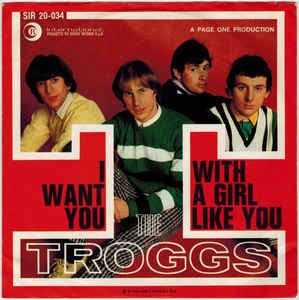Escrita por
John Lennon mas creditada a dupla Lennon/McCartney, foi gravada em 24
de novembro e 22 de dezembro de 1966 e lançada em 13 de fevereiro de
1967 num compacto com Penny Lane. Foi inspirada nas memorias de Lenno
brincando no jardim da Strawberry Field, uma casa de criança do
Exercito da Salvação, perto da casa onde Lennon morou.
Foi a
primeira música gravada durante as sessões do disco Sgt. Peppers.
Tinham a intenção de incluí-la no disco, mas inves disso, sob
pressão da gravadora, lançaram como compacto. Strawberry fields
chegou somente ao numero 8 dos charts americanos.
John Lennon
disse que Strawberry Fields foi a melhor coisa que ele conseguiu
escrever na vida. A canção contem instrumentação reversa e tape
loops, criada da junção de duas versões separada da canção, com
diferentes tempos e tons. Foi inclusa depois no disco Magical Mystery
Tour.
Strawberry
fields é uma dos trabalhos que definem o rock psicodélico e foi
regravada por muita gente. O memorial de Lennon no Central Park, em
NYC, recebeu o nome de Strawberry Fields Memorial. Tanto Strawberry
Fields como Penny Lane dividem o tema nostalgia sobre suas infancias
em Liverpool. Duas obras primas, cada um ao seu modo. Tanto uma
quanto a outra falam de lugares reais, mas com elementos surrais.
Os Beatles
não estavam mais fazendo show depois de um periodo muito dificil na
carreira deles, incluindo a historia de serem mais populares do que
Jesus Cristo e a prisão nas Filipinas porque esnobaram Imelda
Marcos.
Lennon disse
que a musica falava dele, que ele era diferente de todos s vida toda.
Dizia que ninguém estava na mesma arvore que ele e que ele era muito
tímido e cheio de dúvidas e que ninguém parecia ser como ele.
Então, ele pensou, ou ele era um louco ou um genio.
Lennon
começou a escrever a canção na Almeria, Espanha, enquanto filmava
How I won the war, filme em que ele era ator, entre setembro e
outubro de 1966. É a canção número 76 das 500 maiores canções
de todos os tempos da revista Rolling Stone. A mesma revista
colocou-a como a terceira melhor música dos Beatles. Mojo colocou-a
como segunda melhor dos Beatles. Acclaimed music colocou-a como
oitava maior canção de todos os tempos.
Depois de
Strawberry fields, as pessoas da música ficaram sem saber o que
iriam fazer. Eles elevaram o padrão de uma maneira incrível. Não
fazia sentido fazer mais aquelas musiquetas.
John fez os
vocais, tocou violão, bongôs e Mellotron. Paul tocou Mellotron,
baixo, guitarra eletrica, timpani e bongôs.
Foi
regravada por Peter Gabriel, Ben Harper, Richie Havens, Bee Gees,
Noel Gallagher, Cyndi Lauper, Marilyn Mason, The Shadows, Gwen
Stefani, The Ventures, entre outros. George Harrison tocou guitarra
solo slide, swarmandal, timpano e maracas. Ringo tocou bateria e
percussão. George Harrison fez os arranjos do trumpete e do cello.
A letra:
Let me take you
down, 'cause I'm going to Strawberry Fields
Nothing is real and nothing to get hung about
Strawberry Fields forever
Living is easy with eyes closed
Misunderstanding all you see
It's getting hard to be someone but it all works out
It doesn't matter much to me
Let me take you down, cause I'm going to Strawberry Fields
Nothing is real and nothing to get hung about
Strawberry Fields forever
No one I think is in my tree
I mean it must be high or low
That is you can't you know tune in but it's all right
That is I think it's not too bad
Let me take you down, cause I'm going to Strawberry Fields
Nothing is real and nothing to get hung about
Strawberry Fields forever
Always, no sometimes, think it's me
But you know I know when it's a dream
I think I know I mean a "Yes" but it's all wrong
That is I think I disagree
Let me take you down, cause I'm going to Strawberry Fields
Nothing is real and nothing to get hung about
Strawberry Fields forever
Strawberry Fields forever
Strawberry Fields forever
Cranberry sauce
Nothing is real and nothing to get hung about
Strawberry Fields forever
Living is easy with eyes closed
Misunderstanding all you see
It's getting hard to be someone but it all works out
It doesn't matter much to me
Let me take you down, cause I'm going to Strawberry Fields
Nothing is real and nothing to get hung about
Strawberry Fields forever
No one I think is in my tree
I mean it must be high or low
That is you can't you know tune in but it's all right
That is I think it's not too bad
Let me take you down, cause I'm going to Strawberry Fields
Nothing is real and nothing to get hung about
Strawberry Fields forever
Always, no sometimes, think it's me
But you know I know when it's a dream
I think I know I mean a "Yes" but it's all wrong
That is I think I disagree
Let me take you down, cause I'm going to Strawberry Fields
Nothing is real and nothing to get hung about
Strawberry Fields forever
Strawberry Fields forever
Strawberry Fields forever
Cranberry sauce
A versão de
Cyndi Lauper:
A versão de
Noel Gallagher:
A versão de
Ben Harper:














